Erika Mailman's Blog, page 4
January 19, 2018
San Francisco's Musee Mecanique
 Laughing Sal: terrifying children for decades
Laughing Sal: terrifying children for decadesI've never seen anything like the Musee Mecanique, a museum of machines from the turn of the century. Insert a quarter and watch a small scene play out. You can tell it once amazed people as the epitome of what technology was capable of.
The mechanical museum used to be out at San Francisco's Ocean Beach, near the camera obscura behind the Cliff House. And that's probably a big part of why Laughing Sal is there; she was once installed at Playland at the Beach. She positively crackles and quivers as she laughs, the stuff of nightmares.
In a smart move, the museum is now at Pier 45, much easier for Pier 39 tourists to get to. No need to bring a roll of quarters; there are change machines inside.
 My favorite one.
My favorite one. 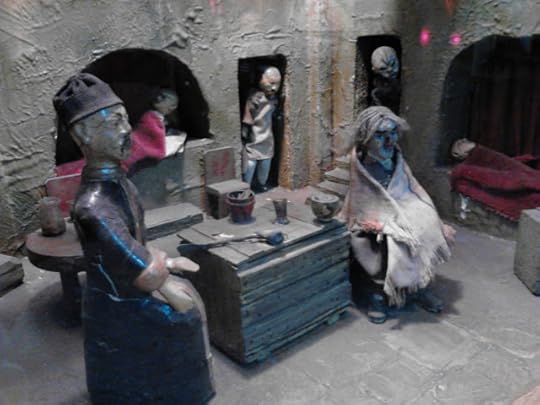 Closeup of the opium den: a crazy dragon comes out of the table
Closeup of the opium den: a crazy dragon comes out of the tableto illustrate the hallucinations the smokers face

 Love the bright colors
Love the bright colors Browsing for antiques
Browsing for antiques This one is part of a huge carnival where all the rides move. This is probably 1/4th of what is visible.
This one is part of a huge carnival where all the rides move. This is probably 1/4th of what is visible. Sigh.
Sigh.For those of you less charmed by such an old-world penny arcade (but...who would that be?), there's also an area in the back with more recent games. State of the art games. Pong, for instance.
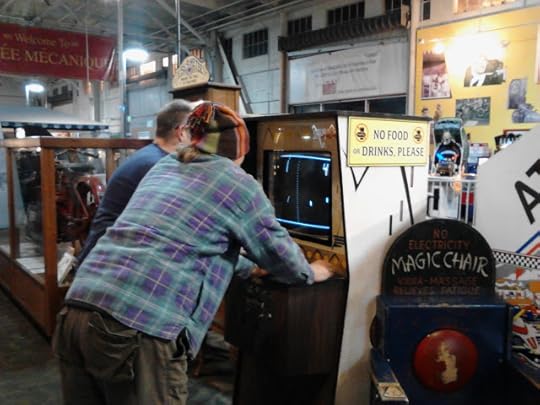
What's your favorite tourist destination in San Francisco? Would love to see comments!
. . . . .
Published on January 19, 2018 08:11
January 18, 2018
The 1918 Flu in Oakland (the "Spanish flu")
 Flu victims quarantined at the Oakland Municipal Auditorium, 1918.
Flu victims quarantined at the Oakland Municipal Auditorium, 1918. In the background, stage scenery separates the “wards.” photo credit: Oakland History Room
Our recent swine flu scare reminded me of another time that our nation braced against an onslaught of disease—but that time it was devastating.
In 1918, a worldwide epidemic of flu killed 400,000 Americans. I first wrote about the flu in 1999 when I found an interesting file on it in the Oakland History Room.
Fear was so great here that City Council passed an ordinance that anyone not wearing a mask over his or her nose and mouth could be arrested. Oakland held the West Coast record for such arrests, estimated to be around 1,000-- this in the period between Nov. 1 and Nov. 22, when the ordinance was repealed.
But the masks were ineffectual. The California State Board of Health issued a report after the epidemic had passed, stating that the masks did not affect the flu’s progress. In fact, they might be anti-beneficial, causing the wearer to repeatedly inhale a warmed percentage of their exhale, creating a fertile ground for germs.
The flu first showed up in Oakland in early October, 1918. Those first six cases were all strangers from out of town. Since the flu originated in the U.S. in Massachusetts in late August 1918, it took a surprisingly short time to make it to our coast, given that airplane travel was not yet common.
Two weeks after those initial six cases, Mayor Davie closed down theaters, schools, churches and poolrooms, just as was recently done in Mexico [note: in 2009], so that large congregations of people would not gather to spread the infection. The wise mayor did not, however, close down the saloons; he merely dictated that they had to use paper cups or sterilize their glasses.
On Oct. 22, the Oakland Municipal Auditorium on the edge of Lake Merritt became an impromptu Red Cross Hospital. A prison chain gang cleaned and mopped the auditorium in preparation for patients.
Since there were no walls to separate the “wards” into male and female sections, someone made the creative decision to use stage scenery (the auditorium had been the site of many theatrical performances). The temporary 500-bed hospital operated for less than a month, but saw a lot of patients in that short time.
The first night it opened, 75 people showed up, and there was only one doctor on staff and no nurses. Red Cross women who were there that night sewing masks graciously offered their assistance. They simply did what they could to keep people comfortable. Later, one nurse worked five days straight without sleeping.
By late October, an astonishing 4,714 Oaklanders had the flu, according to the Fruitvale Progress. On a single day, 214 cases were reported.
By early November, the Oakland death toll was 450. Nationally, there were more deaths from the flu than on the battlefields in France—since WWI was concurrent with this epidemic. On Armistice Day, Nov. 11, a nurse from the municipal auditorium remembered people wild in the streets with celebration, while the patients still lay miserably abed.
By late November, as quickly as it had come on, the flu abated. A second outbreak came in early 1919 (Mayor Davie was arrested in Sacramento for not wearing his mask), a third in Fall 1919, and a fourth in 1920.
* * *Erika Mailman is the author of several historical novels. Reach her through her website, www.erikamailman.com.This column originally appeared in the Montclarion newspaper in 2009, as part of my "Looking Back" column which ran from 1999 to 2011.
Published on January 18, 2018 11:51
January 17, 2018
Bridget the maid was the first to finger Lizzie Borden
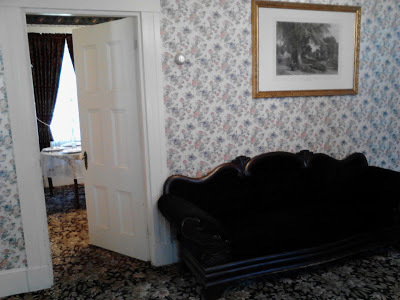 The sofa upon which Mr. Borden took his endless nap
The sofa upon which Mr. Borden took his endless napIn all the hullabaloo of a proper, elderly man being found slaughtered on his own sitting room sofa, and then not too long later, intrepid women climbing the stairs to find his wife on the floor in a similar state, no one thought to ask Lizzie Borden about her possible role in all this.
Not until Irish maid Bridget Sullivan innocently—or not so innocently—asked, “Miss Lizzie, where were you?” *
Can you imagine how quickly eyes must’ve flown to Lizzie’s face? In the house by this point were several neighbors, friends, and a doctor. I loved the simplicity of this phrase so much that I used it verbatim in my novel.
 Attorney Moody and Jay Huguley, who plays him in the upcoming movie Lizzie
Attorney Moody and Jay Huguley, who plays him in the upcoming movie Lizzie At trial, in his opening statement William Moody spoke about this moment. He said Lizzie’s response to Bridget’s question was, “I was out in the back yard, I heard a groan, came in and found the door open and found my father.”
The neighbor Mrs. Churchill saw Bridget out of her window running to fetch the doctor, and she came over to learn more. When she asked Lizzie the same question, Lizzie told her, “I was out in the barn. I was going for a piece of iron when I heard a distress noise, came in and found the door open, and found my father dead.”
After her best friend Alice Russell was fetched by Bridget, Lizzie told her that she was in the barn for a piece of iron or tin to fix a screen (window or door screen).
Moody summed it up nicely:
There is therefore, Bridget Sullivan, to whom she said that she heard a groan, rushed in and found her father; Mrs. Churchill, towhom she said she heard a distress noise, came in and found her father; Officer Mulally, to whom she said she heard a peculiar noise like a scraping, came in and found her father dead; and all those, gentleman, you see in substance are stories which include the fact that while she was outside, she heard some alarming noise which caused her to rush in and discover the homicide.
Well, that sounds decent. She wasn’t clear on the sound, but all the stories contain the same general idea. Innocent!
But wait. Moody went on.
You will find that when she gave a later and detailed account, she said that she went into the loft of the barn, opened the window, ate some pears up there, looked over the leader for some sinkers [for a fishing line], came down, looked into the stove to see if the fire was hot enough that she might go on with her ironing, found it was not, put her hat down, started to go upstairs to await the fire which Bridget was to build for the noonday, and discovered her father. It is not, gentlemen, and I pray your attention to it, a difference of words here. In the one case the statement is that she was alarmed by the noise of the homicide. In the other case the statement is that she came coolly, deliberately about her business…and accidentally discovered the homicide as she went upstairs.
Window screens, fishing lures, pears, haylofts, ironing handkerchiefs…it all sounds like a fever dream.
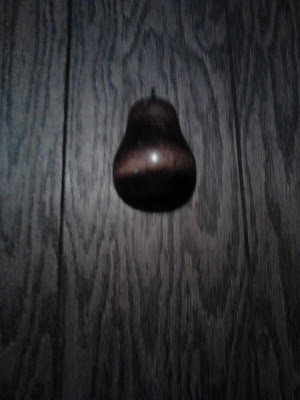 Kitchen cabinets adorned with pears at the Lizzie Borden B&B
Kitchen cabinets adorned with pears at the Lizzie Borden B&BAnd does it help to know this was a ridiculously hot day in August (people had been dying of the heat), and that lingering in a hot loft to eat pears doesn’t sound plausible?
I love reading the old trial testimony, the antiquated syntax. All very pleasurable to me.
And on a final note, given the news that the Chloe Sevigny and Kristen Stewart movie soon to be shown at Sundance may cast these two as lovers, the title of my post may have a special double meaning… I leave it to you to decide.
*Footnote: Bridget asked this question of Lizzie immediately, but it was more fun for the blog post to start this way.
Published on January 17, 2018 08:07
January 16, 2018
Why did Lizzie Borden burn her dress?
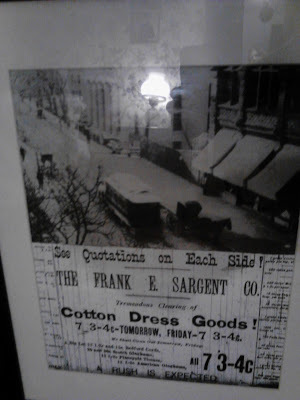 A Bedford cord is a cotton dress good. This advertisement is one I'll
A Bedford cord is a cotton dress good. This advertisement is one I'll blog about later. You can see Bridget Sullivan's lamp reflected in the glass.
Lizzie Borden burned a dress in her kitchen stove shortly after learning she was a suspect for the murder of her father and stepmother. She was seen doing it by her friend Alice Russell, who told the city marshall.
It ended the friendship (Alice was the friend Lizzie sent for upon “discovering” her father’s body) and ensured Alice’s position as a prosecution witness a year later.
Lizzie’s sister Emma was also present during the dress burning episode although Lizzie’s actions were not visible to her. She was washing dishes in the scullery, and calling over her shoulder, advising Lizzie to burn the old, paint-stained dress.
The dress Lizzie burned was a Bedford cord. Emma said in the trial, “It was a blue cotton Bedford cord, very light blue ground with a darker figure about an inch long and I think about three quarters of an inch wide….trimmed with just a ruffle of the same around the bottom, a narrow ruffle.”
The dress had been made by a dressmaker in May; the murders were in August. It took at least two days to make the dress, and yet a few months later it was being pitched into the stove. Apparently, very soon after it had been sewn, within two weeks Emma judged, Lizzie ran into some wet paint on the house walls and ruined it. She continued to wear the dress when indoors without visitors, to the degree that it got “very dirty, very much soiled and badly faded.”
In three months???
On Saturday, the day the house was officially searched—several days after the murders, during which time Lizzie, Emma and Alice had free range of the crime scene—Emma found that she didn’t have a vacant nail upon which to hang her dress. And so she said to Lizzie, “You have not destroyed that old dress yet; why don’t you?”
Now a three-month-old gown was being called “old.”
Dresses were not “ready to wear” in those days. Mrs. Raymond, the dressmaker, came annually to the Borden household to make their dresses for the year. The disappointment of a dress being ruined by paint only weeks after its creation must’ve been severe.
And how did the dress become faded when not worn out in the sun? Perhaps the dye faded from frequent washings—but then why would it be described as soiled?
On Saturday night, Fall River’s Mayor Coughlin came to the house all loose-lipped and Lizzie learned she was a suspect.
On Sunday morning, Lizzie burned the dress.
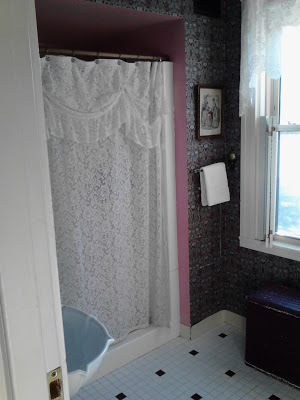 The clothes press is now a bathroom at the Lizzie Borden B&B
The clothes press is now a bathroom at the Lizzie Borden B&BSo you may be asking yourself, why did she bother to burn it after the house was searched? After all, it must’ve been seen by the officers. Well, probably not. They did very cursory examinations of the “clothes press” (a sort of closet for the family) and we can only imagine how uncomfortable the male officers would’ve been, in the “inner sanctum” of the ladies’ garments. It would have been quite easy for Lizzie to fold a dress around the Bedford cord so it wasn’t seen (in fact, multiple dresses must’ve been on single nails since Emma said she couldn’t find a free one). She might’ve even put one dress inside another.
On Monday morning, Alice Russell lied to an investigator that all the dresses had been in the clothespress that were there the day of the tragedy. (It took her a while to come clean). Lizzie and Emma expressed that she should not have lied, and must immediately retract it. Lizzie even took the opportunity to blame Alice for letting her burn the dress: “Why didn’t you tell me? Why did you let me do it?”
 The clothes press was at the top of the stairs where Lizzie laughed
The clothes press was at the top of the stairs where Lizzie laughedIt's killing me that somehow I left the B&B without ever getting a photograph of the reproduction stove and the cupboard next to it where Lizzie had previously stashed the dress she burned.
There is a lot riding on that gown. Was it bloodstained? Why would Lizzie destroy what was clearly to be considered “evidence” by the officers who searched the home? After wearing it all dingy and faded for months, suddenly she couldn’t stand having it around anymore? Was there really such a scarcity of nails?
Many questions… and we don’t have answers, only guesses.
. . . . .
Published on January 16, 2018 11:22
January 15, 2018
Remembering Martin Luther King, Jr.
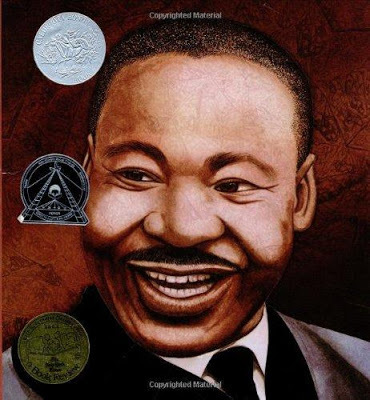
We have this picture book Martin's Big Words and it’s in our rotation year round. It’s so hard to talk about what King fought for without being honest about what he fought against, and it’s so hard to introduce children to the hateful reality of racism. Yet it must be done.
I remember in Francine Prose’s introduction to her book about Anne Frank, she talked about her loss of innocence: the first time she saw a photograph of Holocaust victims and understood that people had been murdered for who they were.
I’d love for my kids to remain in a blissful state where they don’t know about the ugliness in other people’s hearts, but we’re raising them to be good citizens who will stick up for others and do the right thing.
I'm white, and I can imagine that discussion must be a hundredfold harder for black families. How do you tell your child, "There are people in this world who think we are inferior because of the color of our skin?" It just seems incomprehensible.
This selection from King's "Letter from a Birmingham Jail" has long raised tears in my eyes and made me bewilderingly angry:
"...when you suddenly find your tongue twisted and your speech stammering as you seek to explain to your six year old daughter why she can't go to the public amusement park that has just been advertised on television, and see tears welling up in her eyes when she is told that Funtown is closed to colored children, and see ominous clouds of inferiority beginning to form in her little mental sky, and see her beginning to distort her personality by developing an unconscious bitterness toward white people; when you have to concoct an answer for a five year old son who is asking: 'Daddy, why do white people treat colored people so mean?' "
Have you too found it hard to talk about racism with young kids?
I remember once taking a picture book out of the library about slavery and then not wanting to explain to my kids what a slave was. I tried to frame it in terms of, "You're not going to believe it, but this crazy thing once happened in our country..." but then honor and duty compelled me to say, "...and guess what? There are still some people who have this hatred..."
Our local library is really good about ordering diverse picture books, books with people of color on the cover, books about people around the world.
I particularly like this "My Family" series, which features people of diverse ethnicities and sexualities:
http://bit.ly/2mDRVmT
It's about a boy with a camera who features a different kid at school in the newspaper each week, so he goes home with that kid and learns what that kid's life is like. The books are written by Claudia Harrington and illustrated by Zoe Persico.
Another great series were photograph books set in Ethiopia, such as New Shoes for Helen , which is about a girl who needs shoes for her aunt's wedding and where they go to try to find the perfect pair. And Deron Goes to Nursery School, which is self-explanatory. The author/photographer is Ifeoma Onyefulu.
Today and every day, let's honor a great man who was doing such good work to connect all people, and whose life was cut short. Can you imagine what he might've further accomplished had he lived?
. . . . .
Published on January 15, 2018 11:27
January 14, 2018
Lizzie Borden's cemetery
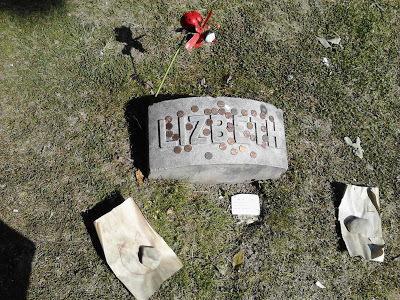
I’ve always been interested in cemeteries, and the one in Fall River, Massachusetts, holding Lizzie Borden’s body is no exception.
After my visit to the Lizzie Borden B&B, my friend and I walked to the Oak Grove Cemetery to see if we could locate Lizzie’s grave, as well as her family members’.
It turns out it wasn’t rocket science. There are literally arrows painted on the ground directing you straight to the Borden plot. Perhaps cemetery staffers were tired of answering the same question over and over and decided to permanently answer it with paint. It was helpful given it was a very hot day in August (as was that fateful day in 1892, when Andrew and Abby Borden were murdered) to not have to meander and find the plot ourselves, but it did seem strange…I wondered if others buried there were miffed they didn’t warrant arrows.
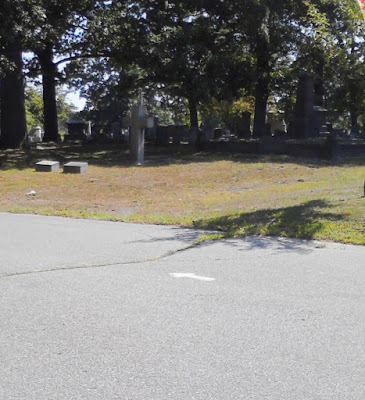 This-a-way, please
This-a-way, pleaseThere’s one Borden monolith for all in this nuclear family, including both wives of Andrew (Sarah died when Lizzie, the youngest, was a toddler).
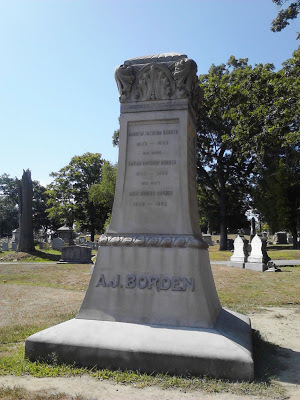
The side that talks about the “Children of Andrew and Sarah” is interesting and listed in order of death date. Alice comes first, the middle child who died in infancy. Interestingly enough, although Lizzie and Emma lived together for years after the murders, they had become estranged by the time of their deaths. They died days apart in 1927.

Each person also gets an individual stone embedded in the earth, and these are scattered with coins by visitors. Please take note that Lizzie is termed “Lizbeth” on this stone and the monolith. That is the name she took for herself after the murders.

Andrew is buried between his two wives.
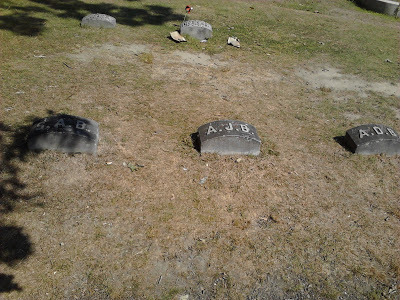
The monumental gates of the cemetery, from the living side…
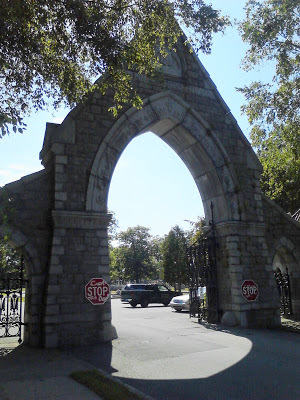
And the dead side.

Do you have a cemetery you particularly liked visiting? Please post it (and links!) in the comments.
. . . . .
Published on January 14, 2018 17:09
January 6, 2018
Wash on Monday, but not if you're Lizzie Borden's maid
 Hungarian women washing clothes, NYPL Digital Collections
Hungarian women washing clothes, NYPL Digital CollectionsThere's an old nursery rhyme that once helped addled housewives remember their duties:
Wash on Monday,
Iron on Tuesday,
Bake on Wednesday,
Brew on Thursday,
Churn on Friday,
Mend on Saturday,
Go to meeting on Sunday.
But not in the Lizzie Borden household. At least not during the week in which Mr. and Mrs. Borden were murdered. We know Irish maid Bridget Sullivan did the washing that week on Tuesday, breaking with a major tradition. Of all her failings, this is surely the one that upsets me the most. ;)
How do we even know such a bit of minutia?
Well, because there happened to have been a bucket of bloody cloths in the basement after the murders. Menstrual cloths, Lizzie told the police investigators. But could they have also included crime scene blood and the rags used to clean it up?
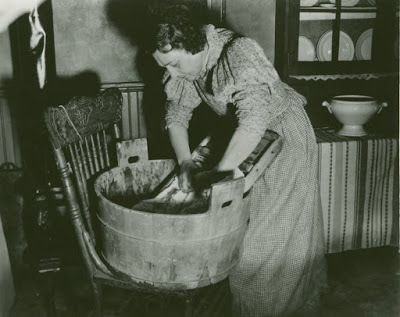 Washing clothes, NYPL Digital Collections
Washing clothes, NYPL Digital CollectionsBefore disposable pads existed, women used real cloth to catch their flow. Victoria Lincoln, author of the Lizzie Borden book A Private Disgrace, first introduced me to the idea of birdseye fabric being specifically used for this purpose. The used fabric would be put to soak until wash day, when the family maid would boil water and begin the arduous task (I initially wrote "harduous," which made me laugh) of washing with soap flakes and multiple rounds of rinsing, all while lifting heavy fabric. I think things are heavy when I move them from the washer to the dryer; I can't imagine being responsible for them when absolutely dripping.
So, Lizzie had her period and was bringing cloths to the basement for soaking. But the timing was interesting. Officer Medley of the Fall River Police Department said he spoke with Lizzie on August 4, 1892, the day of the murders, about the bloody towels. She told him the pail had been there three or four days (i.e., she started menstruating Aug. 1 or 2) and that everything was copacetic; she had already told the doctor about it. Appeal to False Authority, right? The doctor can excuse possible crime scene cleanup materials because he knows all about lady parts.
BUT!
When Medley talked with Bridget Sullivan, she said she had not noticed the pail until the day of the murders, and it could not have been there on Aug. 2 because that was the day she did the washing. August 2 was a Tuesday; the murders were on a Thursday.
Sooooo???
Well, the most important thing obviously is that Bridget didn't follow that housekeeping rhyme. The second most important thing is that all these men were way too squeamish about the bucket, trusted Dr. Bowen's dismissal of it, and failed to follow through with Bridget's assertion that the bucket had only appeared that day.
You can learn more about that bucket, and about Lizzie's midnight visits to the basement (several of them, in the dark, by lantern light) the night of the murders. Her poor friend who accompanied her reported that she walked right past the bloodied clothes of her father and stepmother, left in the pile on the floor, without any concern. Where can you learn more, you ask? Why, in this well-researched novel:
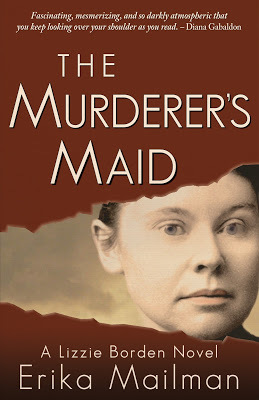
AMAZON
BARNES & NOBLE
POWELL’S
Thanks for reading. More Lizzie facts tomorrow!
. . . .
Published on January 06, 2018 09:52
January 5, 2018
Fancy a listen to Lizzie Borden? She's podcasting (er, sort of)
I wanted to compile in one place the various radio spots I did in support of The Murderer's Maid: a Lizzie Borden Novel. It seems there's a real trend towards podcasts now (I personally LOVED S-Town and am now circling back to the original Serial seasons. I've also enjoyed Malcolm Gladwell's Revisionist History podcast).
I tried to talk about different things in each podcast with the hope that people would want to listen to more than one. Plus, it's more interesting for me when I'm not repeating the same material. However, each usually began with the "Lizzie Borden took an ax" rhyme, since it is the best summary of the case for those who haven't heard of it. So, without further ado, here are five to pick from, with a brief description of each.
 with the incredible Beth Ruyak
with the incredible Beth RuyakINSIGHT WITH BETH RUYAK on Sacramento's Capitol Public Radio, an NPR affiliate11:50 minutesWed., Nov. 15, 2017https://ia800807.us.archive.org/11/it... was such an honor to talk to Beth, a Sacramento anchor in the radio community. She is so gracious and warm and has wonderful questions and a great way of keeping a conversation moving. She had baked zucchini bread that was available to guests in the green room (!). There were several other guests on during the hour and we were all linked by talking about immigrants: my novel's Irish maid (during an era when the Irish were scorned—you can see a little taste of this in the movie Gangs of New York), Chinese immigrants in early Gold Rush California captured in a play, and Japanese-American interned during WWII, in a graphic novel. Three mediums to discuss three cultures. It was a fascinating show. I'm only linking to my segment but you can listen to the others by visiting the Insight site.
My big regret is that I didn't think to mention that Lizzie Borden had taught English to Chinese immigrant boys, and there is a scene of that in my novel.
 Beth's homemade zucchini bread in the Insight green room
Beth's homemade zucchini bread in the Insight green room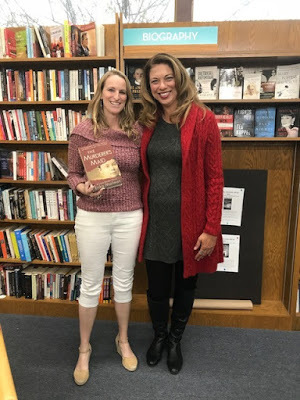 Joey attended my reading at Avid Reader in Sacramento: what a sweetheart! GUEST HOST JOEY GARCIA ON KFBK, Sacramento19 mins (recording continues after my interview ends)Nov. 24, 2017https://www.iheart.com/podcast/139-The-Pat-Walsh-Show-27274639/episode/pat-walsh-show-november-24th-hour-28678564/Joey's a great host, and so fun to talk to. She's also the organizer of a writers conference in Belize (the first ever!) so click here to learn more about that. Joey's an author too, and I've enjoyed getting to know her IRL.
Joey attended my reading at Avid Reader in Sacramento: what a sweetheart! GUEST HOST JOEY GARCIA ON KFBK, Sacramento19 mins (recording continues after my interview ends)Nov. 24, 2017https://www.iheart.com/podcast/139-The-Pat-Walsh-Show-27274639/episode/pat-walsh-show-november-24th-hour-28678564/Joey's a great host, and so fun to talk to. She's also the organizer of a writers conference in Belize (the first ever!) so click here to learn more about that. Joey's an author too, and I've enjoyed getting to know her IRL.THE OPEN MIC WITH RICH EHISENRick and I sat on my back deck and chatted with coffee. He's a great author and journalist who has compiled a book of interviews he's done with authors over the years.
We did two quick Bumpers:1. "Did Lizzie Borden Do It?" 2:26 mins
2. "The Murderer's Maid" 1:22 mins
(He also had our longer interview transcribed. If you prefer to read rather than listen: click here.)
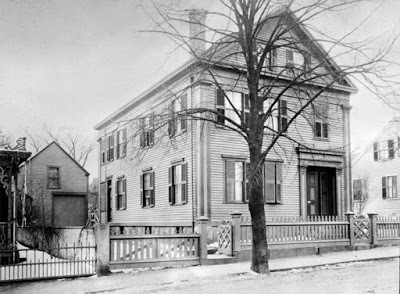 Tim and I talked about the Lizzie Borden house, today a B&B,
Tim and I talked about the Lizzie Borden house, today a B&B, where he has done paranormal investigations SPOOKY SOUTH COAST WITH TIM WEISBERGSaturday, November 25, 2017My interview starts around 16:00. We spoke for about an hour.This interview was unique in that Tim is already a huge Borden case fan and has been to the Lizzie Borden house many times to do paranormal studies. So there was no "let's catch up our listeners on who Lizzie Borden was" and we hit the ground running. He came up with some theories about the case I'd never thought of before, and I reminded him of something he'd forgotten: that the third floor bathroom, next to Bridget Sullivan's room in the attic, was once a bedroom. If you're a serious Lizzie Borden person, this is the one to listen to.Caveat: we had a phone connection (I was not in the studio—we're on separate coasts) that was very wonky and sometimes I literally couldn't hear him. Then another host joined in and I thought she was "static" from another phone line. So apologies if I sound like a dingbat.http://spookysouthcoast.com/murderers-maid-erika-mailman/?utm_content=bufferff172&utm_medium=social&utm_source=twitter.com&utm_campaign=buffer
WOMEN IN HORROR PANEL WITH SF IN SF, San FranciscoThis was a live panel with Loren Rhoads, Dana Fredsti and me, moderated by Terry Bisson. We had a small audience and powerful recording equipment. They assured us they would edit the podcast afterwards, which of course made me eager to do something loony they'd have to edit out. As of this writing, the podcast hasn't been put up on the web yet. I'll circle back and add it as soon as it is.
I'm looking for more podcasts to listen to. I love ones where each episode delivers a new truth or unveils something—the major appeal of S-Town: every episode had a new, strong bit of information to reveal. Can you list your favorites in the comments below?
. . . . .
Published on January 05, 2018 09:13
January 4, 2018
Fancy some taxidermied animals in a cool historic museum?
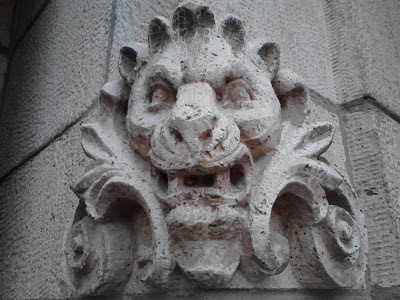 Gargoyle outside front entryLook no further than the Natural History Museum on the K.U. campus in Lawrence, Kansas. Its official name is the KU Biodiversity Institute and Natural History Museum.
Gargoyle outside front entryLook no further than the Natural History Museum on the K.U. campus in Lawrence, Kansas. Its official name is the KU Biodiversity Institute and Natural History Museum.Housed in an absolutely gorgeous four-story stone building that looks exactly like an 1800s professor built a castle to house his antiquities, the museum is a true pleasure to tour.
Many of these dioramas were created for the 1893 World's Fair in Chicago.

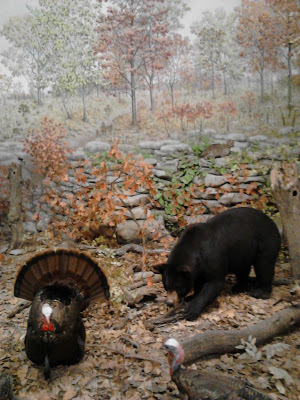
There are taxidermied animals galore. Of course, we have shifted away from the idea of hunting animals to stuff them for display, but since these already exist, they are definitely fascinating. I once wrote about Oakland's no-longer-extant Snow Museum and continue to be intrigued by these frozen creatures.
When we were there last year, a contemporary artist had added some flair, let's say, to the main diorama. This huge exhibit may be the largest in the world (? I've lost my notes) and has many wall-sized glass vantage points. It's a two-story exhibit so you can also look down on it from the second floor. The artist had added a human figure to the diorama at the watering hole...with legs but no torso or head. It really looked like a serial killer's fantasy. The docents were similarly baffled and said the installation had not been met with excitement.

 Second story view of inexplicably dismembered body
Second story view of inexplicably dismembered bodyKansas is known for its fossils, and here's a larger-than-human fish that makes me somewhat glad extinction means I won't run into this swimming in Lake Shawnee.

 This hangs from the ceiling in the entry.
This hangs from the ceiling in the entry.I must apologize for my photos' quality. I took these last year with a desperately ancient droid—surprised I did not find a fossil of it on display, ha ha— and have since happily joined the iphone world (or the 21st century itself, as a friend put it). I'm sad because I took a lot of wonderful family pictures with grandparents and uncles that are similarly blurry. Hopefully, though, there's enough for you to see what a cool museum this is.
The star of the collection is Comanche, the stuffed horse owned by General Custer and the only living thing to survive his Last Stand in 1876. Comanche was previously shot by an arrow in another confrontation with the Comanche (in 1868, hence earning his name for continuing to carry his commander), and was shot by bullets three times at the Battle of Little Big Horn. When he was found two days later, he was there weakly poking around, barely able to stand: the only one left alive.
He was used in parades and lived at Fort Riley, Kansas, until his death in 1891 when he was stuffed.
 Comanche's skin being stretched over an armature
Comanche's skin being stretched over an armature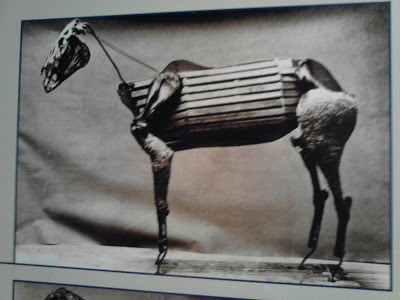 The armature
The armatureThis was my second visit to the museum. When we had gone before, sometime in the '90s to early Oughts, Comanche was in a glass case that permitted you to walk around him and see him from all sides. The top was open to the ceiling. Apparently, the ceiling had leaked and flooded the museum floor and the poor horse was drowned in his own case. This time, he was in a closed case that only permitted viewing from one side. He was in a darkened room to help preserve his multiply-insulted body, which didn't permit my challenged camera to capture it. Here's a link to see his current exhibit status, though.
 ANGERDinosaur lovers will find much to see at this museum.
ANGERDinosaur lovers will find much to see at this museum. 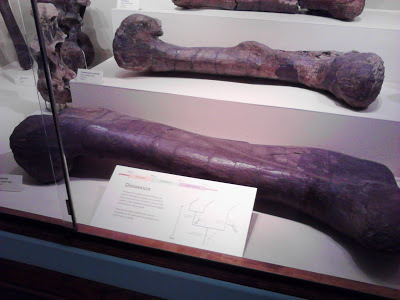 Dinosaur bones
Dinosaur bones
 Interesting collection of various creaturesFinally, across the street we went to the student union and enjoyed the Kansas University spirit. Many thanks to my Kansas relations for taking us to this extraordinary museum!
Interesting collection of various creaturesFinally, across the street we went to the student union and enjoyed the Kansas University spirit. Many thanks to my Kansas relations for taking us to this extraordinary museum!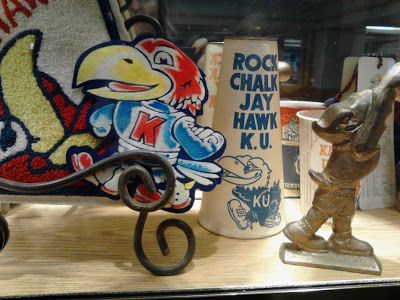
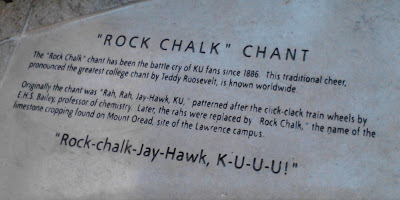
It's not too late to read the next post under this one and comment on it to possibly win a free copy of my latest novel The Murderer's Maid. I'll pick a person tomorrow morning (Jan. 5) randomly from all the correct entries. Hint: there are only two correct entries as of noon on Jan. 4 and so you have a very, very high percentage rate of winning!
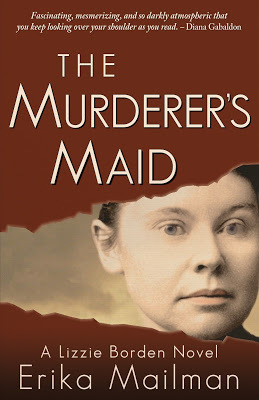 Lizzie Borden attended the 1893 World's Fair with tickets she won!
Lizzie Borden attended the 1893 World's Fair with tickets she won!Lizzie Borden may have actually seen these taxidermied exhibits at Chicago's World Fair. We know she attended with tickets she won in a raffle.
I'd also love it if you'd comment on this post and/or follow my blog. How to follow? If you're on your desktop computer, simply scroll down the right-hand column until you see the blue "follow" button. If you're on your phone, scroll down until you see "view web version" and then read down the right-hand column. This seems to be a one-click pain-free opt-in if you have a gmail account or other easily recognizable email account. There is no need to sign up or give any information, just click.
. . . . .
Published on January 04, 2018 12:24
January 3, 2018
Visit Ancient Egypt! It's here in California (plus secret giveaway)

Yesterday we talked about Ben & Jerry's in Vermont, now we move to Ancient Egypt...in California.
The Rosicrucian Museum in San Jose has a stellar collection of ancient artifacts, including, yes, mummies, and even a wonderful walk-through replica tomb in the basement. The tomb's of such length (three rooms) that younger children will balk, but then feel proud of themselves--perhaps on the second visit!-- when they penetrate into the inner sanctum. The guided tours at the museum are fantastic, but I also recommend going into the tomb without others around, so you can almost convince yourself that it's all real.
Amazing factoid: This is the largest collection of Egyptian artifacts in Western North America.
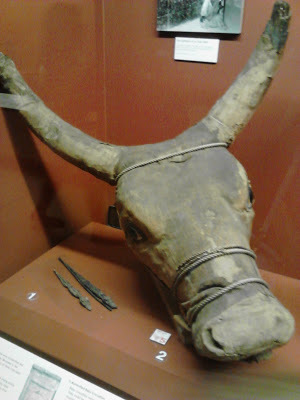
Extras: you can purchase a passport to stamp as you move through the exhibit halls.
The museum also offers a few short classes throughout the day. We sat down for a great one about cosmetics and perfumes. It's fascinating to know what Cleopatra did to smell great! She perfumed the sails of her boat so Mark Antony would fall in love with her before she even set foot on shore. We also learned how Nefertiti got those fabulous eyebrows.
Look at this sarcophagus of Disure, an 18th Dynasty priest and scribe. I guarantee you're going to scroll back up to look at it more closely after you read my text below the photograph.
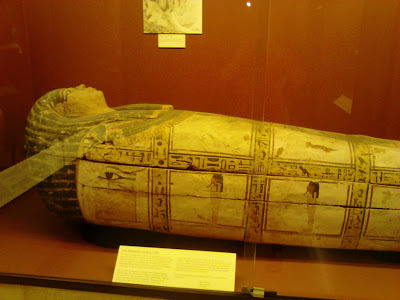
Notice the fully erect guy raring to go? Museums should organize an exhibit called Sex on the Sarcophagus and get Sarah Jessica Parker as a guest presenter.
I'll be kind and give you a close-up, you lascivious person!

You can notice how the image appears scraped in that...er....area. According to the plaque, one of the presumably Victorian owners of the coffin was offended by the sexual nature of the image, tried to dig it out, and only succeeded in making it more prominent.
For Dan Brown fans, it may be interesting to know that the museum was founded by the Ancient Mystical Order Rosae Crucis (AMORC), a mystical society begun in the U.S. in 1915 but dating to ancient times with a connection to Freemasonry. There's no hard sell, or even soft, for the Order, just a small display in the entry hall.
A newer addition is a wonderful Alchemy exhibit. For those interested in the history of medicine (and magic!), this exhibit contains a mock medieval laboratory and several displayed manuscripts, including one that stretches out over eight feet. The Rosicrucian plans to turn this into a full-on museum, which will be the largest such collection in the world. Once up and running, this area will have alchemical workstations for up to 12 students.
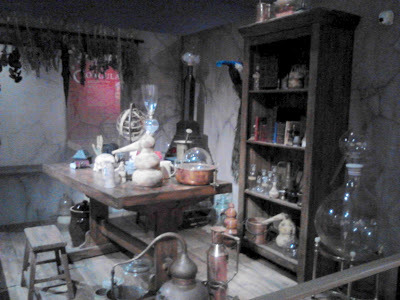
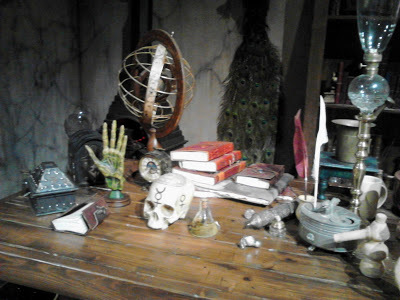
You can even sign 5-17 year olds up for the Junior Archeologist training program, which involves "behind the scenes training, hands-on learning opportunities, and the most fun graduation ceremony this side of the Nile!" It's free with any Friend of the Museum Family Membership.
 Fascinating facts like this abound in the alchemical room
Fascinating facts like this abound in the alchemical roomDid I mention the planetarium?

The gardens and placid walkways?


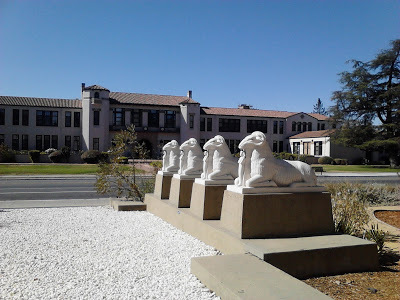 Across the street is a school of some architectural interest, the Herbert Hoover Middle School.
Across the street is a school of some architectural interest, the Herbert Hoover Middle School.The chance to play the ancient game of Senet with game pieces writ large?

We enjoyed playing it so much I considered building a similar outsized Senet in our yard at home.
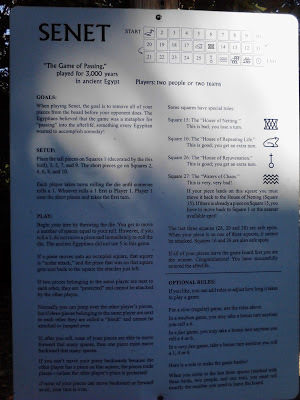
And perhaps best of all for beleaguered Bay Area parkers? The museum hosts a huge, free parking lot.
If you have an Egyptophile in your life, this museum is a must.
 I am the Egyptophile in my life I'll end, as is always appropriate, with canopic jars.
I am the Egyptophile in my life I'll end, as is always appropriate, with canopic jars.
If these canopic jars look familiar, post in the comments below, and tell how you recognize them. I'll send a copy of my novel The Murderer's Maid (to anyone in the U.S.) selected randomly from the correct commenters!
Updated: a lot of people are visiting here but no one is making a guess! Here's a huge hint. Think of the biggest tomb discovery in history (it was memorialized in a Steve Martin song in the 1980s...the grave inhabitant's nickname is only three letters, spelled the same forwards as backwards, a palindrome... the nickname can also be repeated twice to be an old-fashioned, British scolding...). . . .
Published on January 03, 2018 10:34



